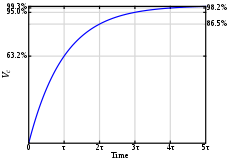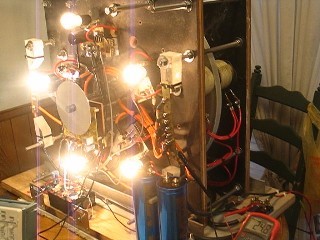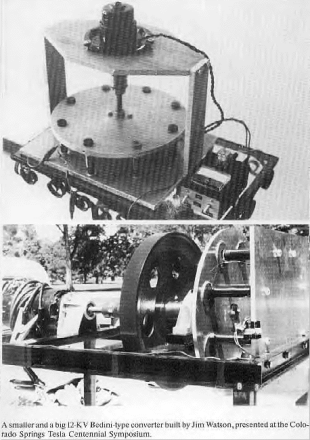Hello Friends
I have been researching and studying free energy devices for more than four
years now, and I think that I have reached to a place, that I can make a
device that extracts energy from the magnet. It is so simple and it should
have been.
This thread is going to serve as a place where I want to share my ideas, and
appreciate ideas from other people to start building devices known to many
but not known to many their reason of operation.
So what am I talking about. I want to tell you how I think the Watson
Machine worked, how the Muller generator operated, and also how Mr Adams
managed to build a machine that was putting more out than in. I also think
that Ismael Aviso has used this technique or a method similar to achieve
those amazing results with his electric car. This seems to be how he charges
his capacitors.
Now lets get down to business. As you may know for a coil to discharge into
a load there is a time constant and a delay which is proportional to (L/R)
where L is the inductance of the coil and R is the resistance of the coil + the
resistance of the Load: RL circuit
- Wikipedia, the free encyclopedia

The small capacitor associated with a coil is also good and serves as a
stabilizer for the voltage. Now because of this time delay, if you move the
magnet past a coil with a reasonable inductance with a small resistance fast
enough you will get to see that the Lenz deceleration becomes Lenz
acceleration. Also one should understand that the speed of acceleration is a
range of operation and if you move the magnet too fast it will not work also.
You can see that Muller puts the coil in front of his large rotor without
noticing any deceleration: YouTube - Bill Muller Coiltest It might be due to his use
of his special core material which increased L considerably, without much
windings and increased the time delay, so the Lenz did not apply to his
system as it should have.

The watson machine was such a device that made the magnets move really
fast with its large rotor, and its large motor. He used to charge batteries
without Lenz law causing deceleration. His large flywheel also assisted this.
Notice the large rotor on the picture:

Don't you see any similarities?
Now this is the Adams motor layout which is too very similar to the two
machines above:

The author in this website:
http://www.totallyamped.net/adams/#top
mentions the fact that the rotor starts accelerating when the resistance becomes low enough.
Also Thane Heins has performed some coil shorting experiments with high
voltage coils (High Inductance) and has reported acceleration:
YouTube - PEREPITEIA GENERATOR
DEMO VIDEO - Parts 1 & 2

As it is evident these are all the same machine, and I don't think that
naming them more names, will help anymore. It is the simplest generator
machine one can imagine: alternating round magnets on a rotor and some
generator coils.
And this is what I have built:

This machine has four alternating polarity 4.5cm diameter magnets, and the
three coils are large enough to make the time constant big enough for an
anti-lenz operation. I have attached a simple DC motor as a prime mover to
make the rotor rotates at about 3000-4000 RPM.
I short the coils and they make the rotor resist rotating up to a certain
speed, which for my system happens to be around 1300 RPM, then it starts
accelerating when the coils are shorted. When it reaches around 4000 RPM,
it even accelerated when I used a 55 watt 12 volt lamp (low resistance)
attached to the output of my three coils. So this is the moment I was waiting
for, lighting a 55 watt lamp to about one fourth its brightness and
accelerating the rotor!! This means you do not need to obey Lenz if you want
to generate energy, you need to go fast enough so that Lenz doesn't see
you!
This design was a proof of concept for me, stay tuned I am going to post
more pictures and videos.
Now if you don't want to make your rotor turn so fast, or you don't want to
use high inductance coils, then the easiest way to extract energy from the
coils is shorting them and collecting the 1000V back-spike with a diode-bridge:
FUELLESS CAR PROTOTYPE by ISMAEL MOTOR
Upright-alternator "shorting-coil" generator-coil circuit - AlternativeWorld Energy

I highly suspect that the African girls free energy unit operates as described
here:

So what are you waiting for, start building your free energy generator, Now!
I am willing to help as many people replicate this as possible. This is nothing
new. We have only been conditioned since childhood that Lenz is God. As
soon as you find out that this is not the case you will build the unit as simple
as a Muller generator, and power your home.
No names will be given to this, it has already got many names. Names make
the device hide behind it, it is the nameless free energy device of the future.
Just build it and help each other, and see for yourselves.
Just posted to help people remove the blocks in their mind. Help us build it.
Elias
I have been researching and studying free energy devices for more than four
years now, and I think that I have reached to a place, that I can make a
device that extracts energy from the magnet. It is so simple and it should
have been.
This thread is going to serve as a place where I want to share my ideas, and
appreciate ideas from other people to start building devices known to many
but not known to many their reason of operation.
So what am I talking about. I want to tell you how I think the Watson
Machine worked, how the Muller generator operated, and also how Mr Adams
managed to build a machine that was putting more out than in. I also think
that Ismael Aviso has used this technique or a method similar to achieve
those amazing results with his electric car. This seems to be how he charges
his capacitors.
Now lets get down to business. As you may know for a coil to discharge into
a load there is a time constant and a delay which is proportional to (L/R)
where L is the inductance of the coil and R is the resistance of the coil + the
resistance of the Load: RL circuit
- Wikipedia, the free encyclopedia

The small capacitor associated with a coil is also good and serves as a
stabilizer for the voltage. Now because of this time delay, if you move the
magnet past a coil with a reasonable inductance with a small resistance fast
enough you will get to see that the Lenz deceleration becomes Lenz
acceleration. Also one should understand that the speed of acceleration is a
range of operation and if you move the magnet too fast it will not work also.
You can see that Muller puts the coil in front of his large rotor without
noticing any deceleration: YouTube - Bill Muller Coiltest It might be due to his use
of his special core material which increased L considerably, without much
windings and increased the time delay, so the Lenz did not apply to his
system as it should have.

The watson machine was such a device that made the magnets move really
fast with its large rotor, and its large motor. He used to charge batteries
without Lenz law causing deceleration. His large flywheel also assisted this.
Notice the large rotor on the picture:

Don't you see any similarities?
Now this is the Adams motor layout which is too very similar to the two
machines above:

The author in this website:
http://www.totallyamped.net/adams/#top
mentions the fact that the rotor starts accelerating when the resistance becomes low enough.
Also Thane Heins has performed some coil shorting experiments with high
voltage coils (High Inductance) and has reported acceleration:
YouTube - PEREPITEIA GENERATOR
DEMO VIDEO - Parts 1 & 2

As it is evident these are all the same machine, and I don't think that
naming them more names, will help anymore. It is the simplest generator
machine one can imagine: alternating round magnets on a rotor and some
generator coils.
And this is what I have built:

This machine has four alternating polarity 4.5cm diameter magnets, and the
three coils are large enough to make the time constant big enough for an
anti-lenz operation. I have attached a simple DC motor as a prime mover to
make the rotor rotates at about 3000-4000 RPM.
I short the coils and they make the rotor resist rotating up to a certain
speed, which for my system happens to be around 1300 RPM, then it starts
accelerating when the coils are shorted. When it reaches around 4000 RPM,
it even accelerated when I used a 55 watt 12 volt lamp (low resistance)
attached to the output of my three coils. So this is the moment I was waiting
for, lighting a 55 watt lamp to about one fourth its brightness and
accelerating the rotor!! This means you do not need to obey Lenz if you want
to generate energy, you need to go fast enough so that Lenz doesn't see
you!

This design was a proof of concept for me, stay tuned I am going to post
more pictures and videos.
Now if you don't want to make your rotor turn so fast, or you don't want to
use high inductance coils, then the easiest way to extract energy from the
coils is shorting them and collecting the 1000V back-spike with a diode-bridge:
FUELLESS CAR PROTOTYPE by ISMAEL MOTOR
Upright-alternator "shorting-coil" generator-coil circuit - AlternativeWorld Energy

I highly suspect that the African girls free energy unit operates as described
here:

So what are you waiting for, start building your free energy generator, Now!
I am willing to help as many people replicate this as possible. This is nothing
new. We have only been conditioned since childhood that Lenz is God. As
soon as you find out that this is not the case you will build the unit as simple
as a Muller generator, and power your home.
No names will be given to this, it has already got many names. Names make
the device hide behind it, it is the nameless free energy device of the future.
Just build it and help each other, and see for yourselves.
Just posted to help people remove the blocks in their mind. Help us build it.
Elias


 Well done - im certainly interested in any other results you get with this set up. I like the simplicity of your explanations too. Very interesting.
Well done - im certainly interested in any other results you get with this set up. I like the simplicity of your explanations too. Very interesting.

Comment